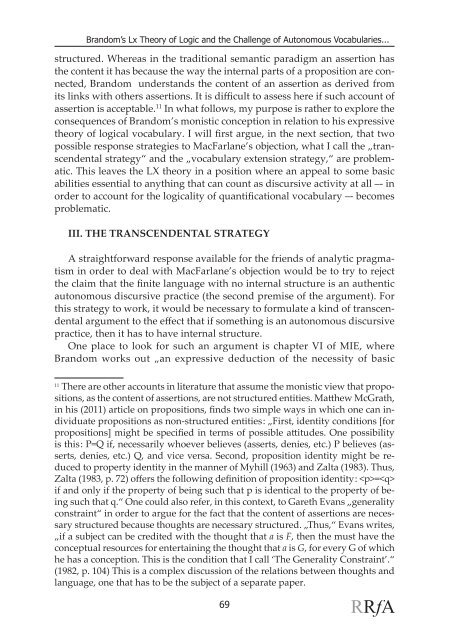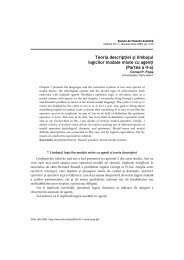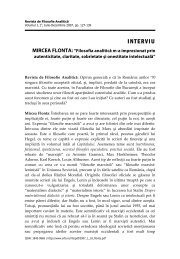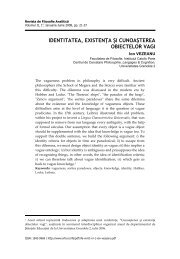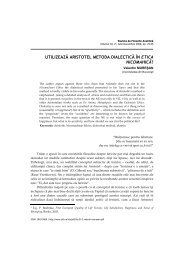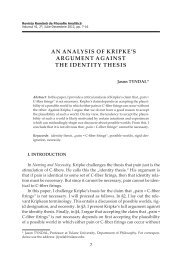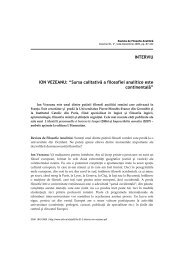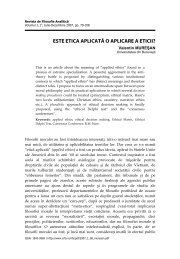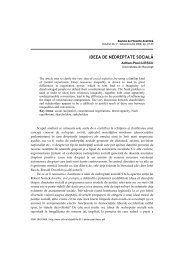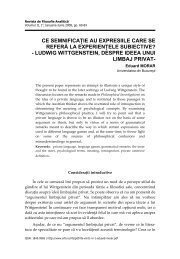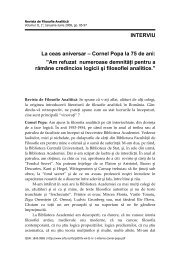brandom's lx theory of logic and the challenge of autonomous ...
brandom's lx theory of logic and the challenge of autonomous ...
brandom's lx theory of logic and the challenge of autonomous ...
Create successful ePaper yourself
Turn your PDF publications into a flip-book with our unique Google optimized e-Paper software.
Br<strong>and</strong>om’s Lx Theory <strong>of</strong> Logic <strong>and</strong> <strong>the</strong> Challenge <strong>of</strong> Autonomous Vocabularies...<br />
structured. Whereas in <strong>the</strong> traditional semantic paradigm an assertion has<br />
<strong>the</strong> content it has because <strong>the</strong> way <strong>the</strong> internal parts <strong>of</strong> a proposition are connected,<br />
Br<strong>and</strong>om underst<strong>and</strong>s <strong>the</strong> content <strong>of</strong> an assertion as derived from<br />
its links with o<strong>the</strong>rs assertions. It is difficult to assess here if such account <strong>of</strong><br />
assertion is acceptable. 11 In what follows, my purpose is ra<strong>the</strong>r to explore <strong>the</strong><br />
consequences <strong>of</strong> Br<strong>and</strong>om’s monistic conception in relation to his expressive<br />
<strong><strong>the</strong>ory</strong> <strong>of</strong> <strong>logic</strong>al vocabulary. I will first argue, in <strong>the</strong> next section, that two<br />
possible response strategies to MacFarlane’s objection, what I call <strong>the</strong> „transcendental<br />
strategy“ <strong>and</strong> <strong>the</strong> „vocabulary extension strategy,“ are problematic.<br />
This leaves <strong>the</strong> LX <strong><strong>the</strong>ory</strong> in a position where an appeal to some basic<br />
abilities essential to anything that can count as discursive activity at all –- in<br />
order to account for <strong>the</strong> <strong>logic</strong>ality <strong>of</strong> quantificational vocabulary –- becomes<br />
problematic.<br />
III. THE TRANSCENDENTAL STRATEGY<br />
A straightforward response available for <strong>the</strong> friends <strong>of</strong> analytic pragmatism<br />
in order to deal with MacFarlane’s objection would be to try to reject<br />
<strong>the</strong> claim that <strong>the</strong> finite language with no internal structure is an au<strong>the</strong>ntic<br />
<strong>autonomous</strong> discursive practice (<strong>the</strong> second premise <strong>of</strong> <strong>the</strong> argument). For<br />
this strategy to work, it would be necessary to formulate a kind <strong>of</strong> transcendental<br />
argument to <strong>the</strong> effect that if something is an <strong>autonomous</strong> discursive<br />
practice, <strong>the</strong>n it has to have internal structure.<br />
One place to look for such an argument is chapter VI <strong>of</strong> MIE, where<br />
Br<strong>and</strong>om works out „an expressive deduction <strong>of</strong> <strong>the</strong> necessity <strong>of</strong> basic<br />
11<br />
There are o<strong>the</strong>r accounts in literature that assume <strong>the</strong> monistic view that propositions,<br />
as <strong>the</strong> content <strong>of</strong> assertions, are not structured entities. Mat<strong>the</strong>w McGrath,<br />
in his (2011) article on propositions, finds two simple ways in which one can individuate<br />
propositions as non-structured entities : „First, identity conditions [for<br />
propositions] might be specified in terms <strong>of</strong> possible attitudes. One possibility<br />
is this : P=Q if, necessarily whoever believes (asserts, denies, etc.) P believes (asserts,<br />
denies, etc.) Q, <strong>and</strong> vice versa. Second, proposition identity might be reduced<br />
to property identity in <strong>the</strong> manner <strong>of</strong> Myhill (1963) <strong>and</strong> Zalta (1983). Thus,<br />
Zalta (1983, p. 72) <strong>of</strong>fers <strong>the</strong> following definition <strong>of</strong> proposition identity : =<br />
if <strong>and</strong> only if <strong>the</strong> property <strong>of</strong> being such that p is identical to <strong>the</strong> property <strong>of</strong> being<br />
such that q.“ One could also refer, in this context, to Gareth Evans „generality<br />
constraint“ in order to argue for <strong>the</strong> fact that <strong>the</strong> content <strong>of</strong> assertions are necessary<br />
structured because thoughts are necessary structured. „Thus,“ Evans writes,<br />
„if a subject can be credited with <strong>the</strong> thought that a is F, <strong>the</strong>n <strong>the</strong> must have <strong>the</strong><br />
conceptual resources for entertaining <strong>the</strong> thought that a is G, for every G <strong>of</strong> which<br />
he has a conception. This is <strong>the</strong> condition that I call ‘The Generality Constraint’.“<br />
(1982, p. 104) This is a complex discussion <strong>of</strong> <strong>the</strong> relations between thoughts <strong>and</strong><br />
language, one that has to be <strong>the</strong> subject <strong>of</strong> a separate paper.<br />
69


